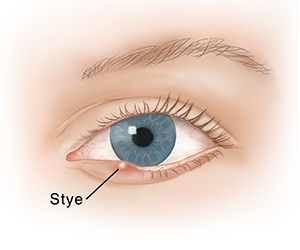When Your Child Has a Stye
A stye is a common problem in children. It’s an infection that appears as a red bump or swelling near the rim of the upper or lower eyelid or under the eyelid. A stye can irritate the eye and cause redness. But it shouldn't be confused with pink eye (conjunctivitis). Unlike pink eye, a stye is not contagious. That means it can’t be spread to another person. A stye is often not a serious problem and can be easily treated.
 |
| A stye is a common infection that appears near the rim of the eyelid. |
What causes a stye?
A stye is caused by an infection in the hair follicle or in the oil gland near the rim of the eyelid or under the eyelid.
What are the symptoms of a stye?
-
Painful red bump or swelling near the eyelid
-
Itchiness of the eye and eyelid
-
Feeling that an object is in the eye
-
Eye discharge or tearing
-
Crusting on the eyelid
How is a stye diagnosed?
A stye is diagnosed by how it looks during an exam. To get more information, the healthcare provider will ask about your child’s symptoms and health history. You will be told if your child needs any tests.
How is a stye treated?
-
Most styes don’t need treatment. But your child’s healthcare provider may prescribe antibiotic eye drops or eye ointment.
-
To help ease your child’s symptoms, apply a warm compress to the stye 3 to 4 times a day. This can be done with a warm, clean washcloth.
-
Don’t squeeze or touch the stye. If the stye drains on its own, cleanse the eye with a warm, clean washcloth.
-
If your child doesn't get better in 4 to 6 weeks, they may be referred to an eye care provider who specializes in eye surgeries and procedures (ophthalmologist). In rare cases, a stye may need to be drained or removed.
When to call your child’s healthcare provider
Call your healthcare provider right away if any of the following occur:
-
Fever of 100.4°F (38°C) or higher, or as directed by your healthcare provider
-
Red or warm skin around the affected eye
-
Drainage from the stye
-
Trouble seeing from the affected eye
-
A stye that won’t go away even with treatment
-
Styes that keep coming back
Online Medical Reviewer:
Chris Haupert MD
Online Medical Reviewer:
Tara Novick BSN MSN
Online Medical Reviewer:
Whitney Seltman MD
Date Last Reviewed:
12/1/2022
© 2000-2025 The StayWell Company, LLC. All rights reserved. This information is not intended as a substitute for professional medical care. Always follow your healthcare professional's instructions.